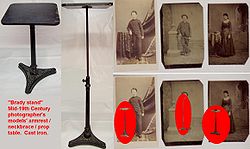Bradyho stojan

Bradyho stojan (angl. Brady stand) se říkalo opěrnému stojanu, který v portrétních ateliérech používali fotografové v polovině 19. století. Jméno nese po Mathew Bradym (1823–1896), což byl americký novinářský fotograf působící v období americké občanské války a známý portrétními fotografiemi významných osobností tehdejší doby.[1]
Popis
Bradyho stojan se používal v daguerrotypických ateliérech v polovině 19. století. Měl těžkou litinovou stabilní základnu, nastavitelnou výšku trubkového sloupce (nohy) pro dvojí použití: sloužil buď jako loketní opěrka, nebo (při plném prodloužení a dodáním příčné výztuhy) jako opěrka hlavy.[2] Ta byla často zapotřebí, aby se modely při delším expozičním času fotografování nepohnuly.[3] Zatímco Bradyho stojan[4] byl vhodný termín pro tyto specifické výrobky ateliérového vybavení, není prokázána souvislost mezi tímto stojánkem a Bradyho vynálezem přibližně z roku 1855.[5]
Galerie
Oscar Gustave Rejlander: Autoportrét s plačícím dítětem, který překreslil a publikoval v Darwinově knize Projev citů u člověka a zvířete, vlevo je vidět opěrka hlavy pro portrétování dlouhým časem
Odkazy
Reference
Související články
Externí odkazy
 Obrázky, zvuky či videa k tématu Bradyho stojan na Wikimedia Commons
Obrázky, zvuky či videa k tématu Bradyho stojan na Wikimedia Commons
Média použitá na této stránce
Self-portrait of O. G. Rejlander: Two emotions. The photo on the easel is The Ginx's Baby, Rejlander's most known work.
Device to hold heads still during the long exposure time required to make a Daguerreotype portrait
TITLE: A photographer appears to be photographing himself in a photographic studio: Wheeler, Berlin, Wis.
A composite photograph showing a photographic studio interior. One man is seated on a stool near an adjustable clamp to hold his head steady during a long portrait exposure. The second man, standing next to a large view camera, looks like the person being photographed.
Satire on photographic practices.Cast iron "Brady stand" side table. As perhaps the best-known US photographer in the 19th century, it was Mathew Brady's name that came to be attached to the era's heavy specialized end tables which were factory-made specifically for use by portrait photographers. Such a "Brady stand" of the mid-19th century typically had a weighty cast iron base for stability, plus an adjustable-height single-column pipe leg for dual use as either a portrait model's armrest or (when fully extended and fitted with a brace attachment rather than the usual tabletop) as a neckrest.[1] The latter was often needed to keep models steady during the longer exposure times of early photography.[2] While Brady stand is a convenient term for these trade-specific articles of studio equipment, there is no proven connection between Brady himself and the Brady stand's invention circa 1855.[3]
A Brady stand is clearly visible in use in context in the late 19th century period novelty photo of a "photographer photographing himself" see Commons image: http://en.wikipedia.org/wiki/File:Photographer-studio-1893.jpg






